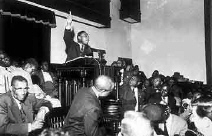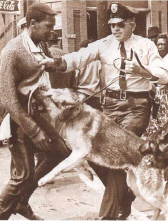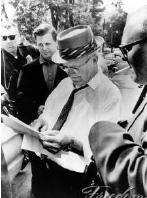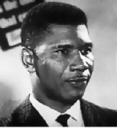Multiple Choice
Identify the
choice that best completes the statement or answers the question.
|
|
|
Riding for
Freedom
James Peck, a white
civil rights activist, was one of six whites and seven blacks who set out from Washington, D.C ., in
1961 on a special bus ride through the South. The trip was part of CORE’S attempt to test
the Supreme Court decisions banning segregated seating on interstate bus routes and segregated
facilities in bus terminals . The activists formed two interracial teams of freedom riders to
travel through the South challenging |  | segregation .
They reasoned that if they provoked a violent reaction, the Kennedy administration would have
to enforce the law. In Anniston, Alabama, about 200 angry whites attacked Bus Two, kicking its sides
and slashing its tires . The driver managed to take the damaged bus six miles out of town before one
of the slashed tires blew apart. The mob, which had driven after the bus, barricaded the door while
someone smashed the rear window and tossed in a fire bomb . The freedom riders forced open the door
and spilled out just before the bus exploded in a ball of flame.
NEW VOLUNTEERS
CORE’S freedom riders did not want to give up, but
the bus companies refused to carry them any farther, so they ended their ride and nearly all of them
boarded a flight to New Orleans . Then Diane Nash, a SNCC leader, called CORE director James Farmer
to say that a group of Nashville students wanted to resume the freedom ride. “You know that may
be suicide,” warned Fariner. Nash answered, “We know that, but if we let them stop us
with violence, the movement is dead! . . . Your troops have been badly battered. Let us pick up the
baton and run with it When the SNCC volunteers rode into Birmingham, Police Commissioner Eugene
“Bull” Connor’s men pulled them off the bus, beat them, and drove them into
Tennessee. The determined young people returned to Birmingham and occupied the whites-only waiting
room at the terminal, where they sat for 18 hours because the bus driver refused to risk his life
transporting them. After receiving an angry phone call from U.S. Attorney General Robert Kennedy, bus
company officials convinced the driver to proceed. The SNCC volunteers set out for Montgomery on
May20. | | |
|
|
|
1.
|
Why did groups of civil rights
workers start out on “Freedom Rides” through the South?
a. | It was safer to ride in
groups | c. | They wanted to test the Supreme
Court decision that desegregated interstate buses. | b. | Freedom busses were the only transportation available in
the South | d. | The Freedom Bus Company had the
cheapest fairs in the South |
|
|
|
2.
|
What organization sponsored the
Freedom Rides?
a. | Colored Organizations for Racial
Equality | c. | Congress Of Racial
Equality | b. | Colored Organizers for Racial Equality | d. | Congressional Officers for Ending
Racism |
|
|
|
3.
|
Who was the police commissioner
of Birmingham who tried to break up the Freedom Rides?
a. | Bull
Conners | c. | James
Farmer | b. | George Wallace | d. | James Peck |
|
|
|
4.
|
Which organization was most
aggressive and confrontational about fighting for racial integration
a. | NAACP | c. | SNCC | b. | CORE | d. | None of these were aggressive |
|
|
|
 | ARRIVAL OF
FEDERAL
MARSHALS
Although Alabama officials had promised Kennedy that the riders would be
protected, no police were stationed near the Montgomery terminal when the bus arrived. Instead, a mob
of whites-many carrying bats and lead pipes-fell upon the riders . John Doar, a Justice Department
official on the scene, called the attorney general and reported what happened. “A bunch of men
led by a guy with a bleeding face are beating [the passengers] . There are no cops.
It’s terrible . It’s terrible . There’s not a cop in sight. People are yelling,
‘Get ‘em, get ‘em.’ It’s awful.” The violence
| provoked exactly the response the freedom riders had been
hoping for. Newspapers throughout the nation and abroad denounced the beatings. Southern
newspapers such as the Atlanta Constitution, which had criticized the freedom ride, expressed outrage
that police had refused to protect the riders . President John F Kennedy decided to give the
freedom riders more direct support. This time, the justice Department sent 400 U.S . marshals to
protect the riders on the last part of their journey to Jackson, Mississippi. In addition, the
attorney general and the Interstate Commerce Commission issued an order banning segregation in all
interstate travel facilities, including waiting rooms, restrooms, and lunch counters
.
| | |
|
|
|
5.
|
What happened when the Freedom
Riders arrived in Montgomery, Alabama?
a. | They were beaten by the
police | c. | They were greeted by the
mayor | b. | They were beaten by an angry mob | d. | They were met by angry Justice Department
officials |
|
|
|
6.
|
What was the attitude of the
police toward the violence imposed on the Freedom Riders when they arrived in
Montgomery?
a. | They condoned
it | c. | They instigated
it | b. | They opposed
it | d. | They most likely did not know about
it |
|
|
|
7.
|
How did the Justice Department
react to the beatings of the Freedom Riders in Montgomery?
a. | They ignored the
beatings | c. | They sent federal
marshals to protect the riders | b. | They condoned the beatings | d. | They took control of the bus
company |
|
|
|
8.
|
Interstate commerce means commerce between two or more states, not just inside a state.
The U.S. government has authority over interstate commerce because it is between states. What was the
result of the Freedom Rider beatings in Montgomery?
a. | The Freedom Riders gave
up. | c. | The bus company stopped freedom
rides because they involved interstate commerce. | b. | segregation was banned on all travel facilities, including
waiting rooms, restrooms, and lunch counters by the state of
Alabama | d. | segregation was banned on all travel facilities, including
waiting rooms, restrooms, and lunch counters by the U.S.
government |
|
|
|
9.
|
What was the end result of the
Freedom Rider beatings in Montgomery, Alabama?
a. | public opinion turned in against the
Riders and segregation was banned on the busses | c. | public opinion turned in favor of the Riders and segregation was banned on the
busses. | b. | public opinion turned in favor of the police and gave them more power to
impose law and order in Montgomery | d. | the State of Georgia and the city of Montgomery came out looking like the
victims |
|
|
|
10.
|
The Interstate Commerce
Commission is an agency of
a. | the state of
Alabama | c. | the Constitution
of the United States | b. | the city of Birmingham, Alabama | d. | the United States government |
|
|
|
Standing Firm
As interstate
travel facilities became more fully integrated, some civil rights workers turned their attention to
integrating some Southern schools and pushing the movement into additional Southern towns. At each
turn they encountered opposition from some whites .
“Violence is a fearful thing,”
recalled Avon Rollins of SNCC . “I remember when I had to take a stand, where the words
wouldn’t come out of my mouth, . . . because the fear was in me so strong
.”
INTEGRATING OLE MISS
In September 1962, Air Force veteran James
Meredith won a federal court case that allowed him to enroll in the all-white University of
Mississippi, nicknamed Ole Miss. But when Meredith arrived on campus, he faced Governor Ross
Barnett, who refused to let him register as a student. Following the precedent set by
Eisenhower in Little Rock, President Kennedy ordered federal marshals to escort Meredith to the
registrar’s office . Barnett responded with a heated radio appeal : “I call on
every Mississippian to keep his faith and courage. We will never surrender.” The broadcast
turned out white demonstrators by the thousands . On the night of September 30, riots broke out on
campus that resulted in two deaths . It took more than 5,000 soldiers, 200 arrests, and 15 hours to
stop the rioters . In the months that followed, federal officials accompanied Meredith to class and
protected his parents from nightriders who shot up their house.
| |
|
|
|
11.
|
When _____ arrived on the
University of Mississippi to enroll, he was opposed by _____ .
a. | James Meredith - Governor Ross Barnett | c. | Freedom Riders - the Justice Department | b. | James Meredith - Governor George
Wallace | d. | Avon Rollins - Governor Ross
Barnett |
|
|
|
12.
|
What did the U.S. government do
in regards to the enrollment of James Meredith at “Ole Miss”
a. | Correctly stated that it was a state
matter and the U.S. government had no authority | c. | Sent marshals to protect and escort Meredith to
class | b. | Asked former President, Eisenhower to
intervene. | d. | Cut off all federal funds to the
University of Mississippi |
|
|
|
13.
|
How did the people of
Mississippi react to the radio speech of the Governor?
a. | By rioting on campus
| c. | The people ignored
it | b. | They calmed
down | d. | By dropping out of the
University |
|
|
|
HEADING INTO
BIRMINGHAM By 1963, Reverend Fred
Shuttlesworth, head of the Alabama Christian Movement for Human Rights, decided that something had to
be done about Birmingham-a city known for its strict enforcement of total segregation in public life
. The city also had a reputation for racial violence, including 18 bombings from 1957 to 1963.
Deciding that Birmingham would be the ideal place to test the power of nonviolence, Shuttlesworth
invited Dr. Martin Luther King, Jr., and the SCLC to help desegregate the city. On April 3, 1963,
King flew into Birmingham to hold planning meetings with members of the African-American community.
“This is the most segregated city in America,” he said. ‘We have to stick together
if we ever want to change its ways.”
After several days of demonstrations led by Shuttlesworth and others, King led a small
band of marchers into the streets of Birmingham on Good Friday, April 12. Police Commissioner Bull
Connor promptly arrested them. While sitting in his jail cell, Dr. King wrote an open letter to white
religious leaders who felt he was pushing too hard, too fast .
On April 20, King posted bail and
began to plan more demonstrations . On May 2, more than a thousand African-American children marched
in Birmingham ; Bull Connor arrested 959 of them. On May3, a second “children’s
crusade” came face to face with Connor and his helmeted police force . As television cameras
recorded the scene, the police swept the marchers off their feet with high-pressure fire hoses, set
attack dogs on them, and clubbed those who fell . Millions of TV viewers heard the children
screaming. Continued protests, an economic boycott, and negative media coverage finally
convinced Birmingham officials to meet King’s demands for an end to segregation . Birmingham
offered a stunning civil rights victory that inspired African Americans across the nation. In
addition, it convinced President Kennedy that nothing short of a new civil rights act would end the
disorder and satisfy the demands of African Americans-and many whites-for racial
justice.
|

Dr King speaks in
Birmingham

Police dogs attack
demonstrators

Bull Conners - Police Chief of
Birmingham, Alabama | | |
|
|
|
14.
|
Birmingham, Alabama was chosen
as a city to test the non-violent approach to ending segregation because
a. | it had a history of
violence | c. | both of these
reasons | b. | it was one of the most segregated cities in the
nation |
|
|
|
15.
|
It is safe to say that Dr. King
and the _____ was trying to _____ violence to call attention to the segregation
issue.
a. | SNCC -
provoke | c. | SCLC - avoid
| b. | SCLC - provoke
| d. | SNCC -
prevent |
|
|
|
16.
|
Which person did exactly what
his opposition wanted him to do in Birmingham.
a. | Dr.
King | c. | President John
Kennedy | b. | Reverend Fred Shuttlesworth | d. | Bull Conners |
|
|
|
17.
|
What was the result of Bull
Conners actions in Birmingham?
a. | Thousands of demonstrators were
killed | c. | The city was
desegregated | b. | The city became more segregated | d. | Most of the black children in the city were beaten and
jailed. |
|
|
|
18.
|
The events in Birmingham,
Alabama in 1963 demonstrated
a. | the fact that the American people
did not care what happened to African Americans | c. | the basic fairness of the American people when exposed to an
injustice | b. | the indifference of the Kennedy administration toward racial
injustice | d. | that the American people did not
want to integrate with African Americans |
|
|
|

George Wallace

JFK
| KENNEDY TAKES A STAND
On June 11, 1963, President Kennedy used federal troops to
force Governor George Wallace to honor a court order desegregating the University of Alabama. That
evening, Kennedy addressed the nation and asked pointedly, “Are we to say to the world-and much
more importantly, to each other-that this is the land of the free, except for the Negroes?” He
referred directly to “repressive police action” and “demonstrations in the streets
.” Then, he demanded that Congress pass a sweeping civil rights bill
A tragic event just
hours after Kennedy’s speech highlighted the racial tension in much of the South. Shortly after
midnight, a sniper shot and killed Medgar Evers-NAACP field secretary and World War II veteran-in the
driveway of his home in Jackson, Mississippi. Police soon arrested white supremacist Byron de la
Beckwith for the crime, but he was released after two trials resulted in hung juries . (De la
Beckwith was finally convicted in 1994, after the case was reopened based on new evidence .) The
release of de la Beckwith brought a new militancy to African Americans. With raised fists, many
demanded, “Freedom now!”


Byron de la
Beckwith Medgar
Evers
| | |
|
|
|
19.
|
Medgar Evers was
a. | a WWII veteran and NAACP field
worker | c. | Governor of
Alabama | b. | President of the U.S. | d. | charged with murder |
|
|
|
20.
|
JFK was
a. | a WWII veteran and NAACP field
worker | c. | charged with
murder | b. | President of the U.S. | d. | Governor of Alabama |
|
|
|
21.
|
Beckwith
was
a. | Governor of
Alabama | c. | charged with
murder | b. | President of the U.S. | d. | a NAACP field worker |
|
|
|
22.
|
George Wallace
was
a. | charged with
murder | c. | an NAACP field
worker | b. | Governor of Alabama | d. | leader of SNNC |
|
|
|
23.
|
What did Kennedy ask Congress
to do?
a. | pass a civil rights
bill | c. | send marshals to Alabama to enforce
segregation | b. | send troops to Alabama to protect
demonstrators | d. | send marshals to Alabama to enforce
integration |
|
|
|
24.
|
Byron de la Beckwith was
arrested and convicted in 1963 for shooting Medgar Evers
|
|
|
25.
|
How did African Americans react
to the trial of de la Beckwith in 1963?
a. | satisfaction | c. | anger | b. | sadness | d. | anticipation |
|